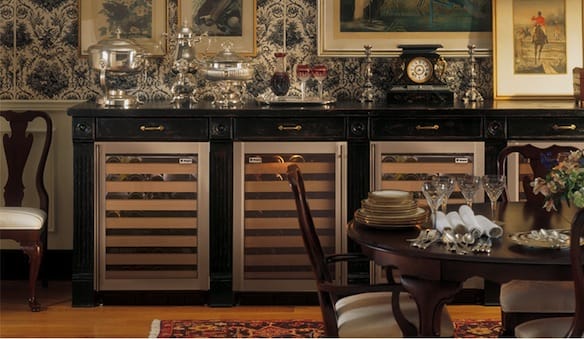
Image credit: Monogram.
Wine Refrigerator Buying Guide
Wine. The Greeks invented it, the Romans improved it, the French turned it into a national heritage, and we Americans are drinking more of it every passing year. No matter whether it’s a low-price red you found in the bargain bin to go with a take-out pizza, or a break-the-bank Chassagne-Montrachet white for a special occasion, wine makes every occasion better. However, like many good things, wine can be fragile. It’s not like beer, which can be stored in cans in the basement and chilled when you want them. For any wine – el-cheapo or extravagant – to taste its best, it needs to be stored on its side to prevent the cork from being dried out, at the right coolness to preserve its chemistry, and with the lowest possible harmful ultraviolet light penetrating the bottle.
Your kitchen fridge might work in a pinch to keep a bottle of white wine cold for a few months. But if you’re serious about your wine drinking, whether it’s with that mushroom pizza or haute cuisine, you’ll want a specialized wine refrigerator that can hold many bottles in the right conditions.
There are certain common qualities of wine refrigerators. They keep wine at the perfect storage temperature of between fifty and fifty-five degrees Fahrenheit. They store your wine on its side. They’ll minimize the amount of light that can reach your bottles. With these commonalities, though, come some differences from model to model. Here are the choices you’ll be making:
How Many Bottles?
How many bottles your fridge should hold will depend largely on the amount of wine that you keep in your household at any time. If you’re a serious wine collector who buys by the case, you already know that a regular wine fridge won’t be adequate. You’re in the ambit of sophisticated wine cellaring. For the rest of us, wine fridges tend to hold from twenty bottles to fifty-six bottles, and even more if it’s designed to age wine as you might in a cellar. A good rule of thumb for purchase is to think about the maximum number of bottles you’ve had in your household at any one time (excluding massive parties!), and then double that number to find your fridge capacity. With so many wine sellers offering “buy one, get one almost free” deals, you want to be in a position to take advantage of the bargain.
Interior Configuration
Wine refrigerators store wine on their sides, which makes the most efficient use of their space. Some of them come with pre-fitted concave half-circles in their racks, where your typical 750 ml. wine bottle can rest. That’s fine, until you come home with a 375 ml. bottle of something special, or even a magnum. How frustrating, to find that your purchase doesn’t fit in your fridge. Therefore, think carefully about your past and future wine purchases, and buy a wine refrigerator with removable or flexible racking if you think you’ll need it. The shelves themselves also present different options. They can be made of plastic, metal, or wood. Plastic tends to be least expensive but flimsiest. Wood is sturdiest, but most costly. The shelves do make a difference. One of your goals in wine storage is to minimize the movement of your wine while it’s at rest. Wine that’s subject to the shakes is wine that won’t be at its best.
Sight and Sound
Aesthetics can make a difference with wine refrigerators. If the fridge is down in your basement, it doesn’t much matter what it looks like or how much noise it makes, but if you’re putting the fridge in your kitchen, dining room, or den, the sight and sound of your fridge matter quite a bit. Wine fridges can be very beautiful, with paneled or stainless steel exteriors and smoked or tinted glass on the door. Or, they can be utilitarian. Shop around to find one that works best with your environment. At the same time, give the fridge a good listen. That fridge cooling system is going to be at work pretty often; the motor will run and you may hear a significant hum. Some systems are quieter than others. Don’t ignore what your ears are telling you.
Extra Points
Some wine fridges come with cooling compartments, just like kitchen refrigerators. You can adjust the temperature separately for each compartment, which could be helpful if you are storing wines in prep for serving. Also, check the interior lighting of your wine fridge so that you can easily identify bottles without removing them from the unit. You don’t want to keep your guests waiting…or that mushroom pizza that you’re raring to enjoy with a good red.



